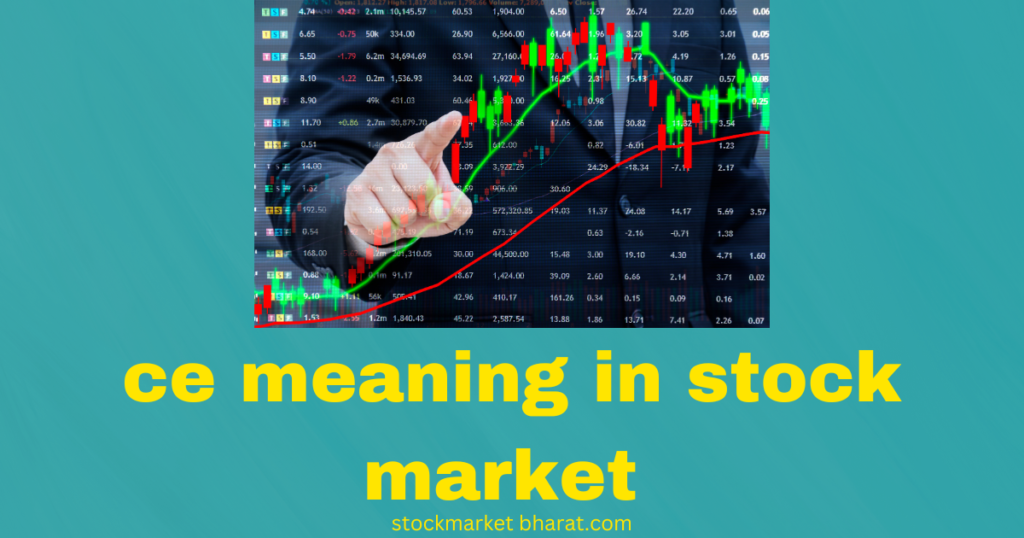CE Meaning in Stock Market

Understanding CE (Call Option) in the Stock Market
The stock market is filled with various financial instruments that traders and investors use to maximize their returns. One such instrument is CE (Call Option), which plays a significant role in options trading. If you’re new to the world of derivatives trading, understanding what CE means in the stock market can help you make informed investment decisions.
In this blog, we will discuss what CE (Call Option) is, how it works, its advantages, risks, and how traders use it in the stock market.
What is CE in the Stock Market?
CE stands for Call European, but in stock market terminology, it simply refers to a Call Option (CE). A Call Option is a financial contract that gives the buyer the right, but not the obligation, to buy an underlying asset (stock or index) at a predetermined price (strike price) before or on the expiration date.
Key Characteristics of CE (Call Option):
- A buyer of CE has the right to buy the stock at a fixed price within a specified time.
- The seller of CE is obligated to sell the stock if the buyer chooses to exercise the option.
- Call options are traded in the derivatives market (F&O segment) on exchanges like the NSE and BSE.
- CE options are used for speculative trading, hedging, and investment strategies.
How CE (Call Option) Works?
To understand how CE works, let’s take an example:
- Suppose Reliance Industries is trading at ₹2,500.
- A trader expects the stock price to rise and buys a CE option with a strike price of ₹2,600 at a premium of ₹50.
- If the stock price rises to ₹2,700 before expiration, the trader can exercise the option and buy Reliance shares at ₹2,600, making a profit.
- The profit calculation would be:
Profit = (Stock Price – Strike Price – Premium) × Lot Size
Profit = (₹2,700 – ₹2,600 – ₹50) × Lot Size - If the stock price remains below ₹2,600, the option expires worthless, and the trader loses only the premium paid.
Why Do Traders Buy CE Options?
1. Speculative Trading
- Traders buy CE options when they expect a stock or index to move upward in the short term.
2. Limited Risk, Unlimited Profit Potential
- The maximum risk for a CE buyer is the premium paid, while the profit potential is unlimited if the stock price rises significantly.
3. Leverage Advantage
- Options trading allows traders to control a large position with a smaller investment compared to buying stocks directly.
4. Hedging Portfolio Risks
- Investors holding stocks can buy CE options as insurance against market downturns.
Factors Affecting CE Option Prices
The price of a CE option depends on multiple factors:
1. Stock Price Movement
- If the stock price moves above the strike price, the value of the CE increases.
2. Time Decay (Theta)
- As the option approaches expiry, its value decreases due to time decay.
3. Market Volatility (Vega)
- Higher volatility increases the option premium because there’s a higher chance of the stock reaching the strike price.
4. Interest Rates and Dividends
- Changes in interest rates and upcoming dividend payments impact CE prices.
CE Option Trading Strategies
Traders use different strategies with CE options to maximize profits and manage risks:
1. Buying CE for Bullish View
- When traders expect a stock to rise, they buy CE options.
- Best suited when markets are trending upwards.
2. Selling CE for Bearish View
- Traders sell CE options when they believe the stock price will stay below the strike price.
- The seller collects the premium but risks unlimited losses if the stock rises sharply.
3. Covered Call Strategy
- Investors holding stocks sell CE options to generate additional income from premiums.
4. Bull Call Spread
- Buying a lower strike CE and selling a higher strike CE to reduce costs and manage risks.
ALSO READ: what-is-long-unwinding-in-stock-market
Advantages of CE Options
- Low Investment: Buying CE options requires a lower capital investment than purchasing stocks.
- High Returns Potential: If the stock price rises significantly, CE options offer substantial returns.
- Flexible Strategies: CE options allow traders to hedge risks and speculate in both bullish and neutral markets.
- Defined Risk: The maximum loss is limited to the premium paid.
Risks of CE Options
- Premium Loss: If the stock doesn’t move above the strike price, the entire premium is lost.
- Time Decay: As expiry nears, the value of the CE erodes, especially if the stock remains stagnant.
- Market Volatility: Sudden market changes can reduce the option’s value unexpectedly.
CE vs PE (Call Option vs Put Option)
| Feature | CE (Call Option) | PE (Put Option) |
|---|---|---|
| Buyer’s View | Bullish | Bearish |
| Right to… | Buy stock | Sell stock |
| Profit When | Stock price rises | Stock price falls |
| Risk | Limited to premium | Limited to premium |
Conclusion
CE (Call Option) is a powerful financial instrument in the derivatives market that allows traders to benefit from stock price increases with limited risk. Understanding how CE options work, their advantages, risks, and trading strategies can help traders make smarter investment decisions.
Before trading CE options, it’s crucial to analyze market trends, volatility, and technical indicators. Whether you’re a beginner or an experienced trader, mastering options trading can open new opportunities in the stock market.
For more stock market insights, keep learning and stay updated with market trends! 📈💡